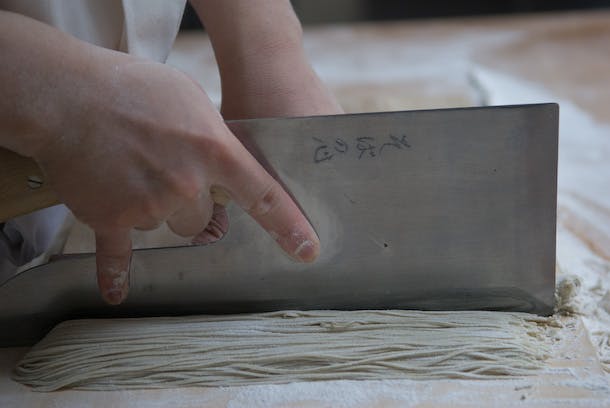
Matsugen Soba
Learn about the high art of soba noodles at Matsugen, a restaurant in Manhattan, where the chef generously shares the fascinating process of making, cutting, and cooking soba noodles. Experience the toothsome and delightful cold inaka style noodles with a delicate dipping sauce, showcasing the exquisite taste of soba.
Working on a manuscript this past spring for a Japanese noodle cookbook gave me a chance to do a bit of research on ramen, soba, udon and somen. Soba, buckwheat noodles, I found particularly interesting, because they're both a down-home soul food and something more rarefied. That "something more rarefied" side to soba can now be found at a terrific new restaurant in Manhattan called Matsugen, where I recently visited the chefs there to learn more about their noodles.
Matsugen is a joint production between Chef Jean Georges Vongerichten and a trio of brothers from Japan, who run two other Matugen restaurants in Tokyo and Honolulu. Their goal was to bring the high art of soba to New York (especially after the close of the beloved Honmura An), and judging from the recent three star Times review, they clearly succeeded.
I dropped in between service watch one of the chefs prepare soba. Please check out the photos below. All of Matsugen's soba is handmade, which is a fascinating process. It starts with the actual buckwheat kernels, which are flown in from Hokkaido and ground into flour in a high-tech grinder that mimics a traditional one -- the kernels are ground between two solid granite wheels and then sifted.
The chef quickly worked the fresh flour into dough by mixing it by hand a large bowl. Matsugen offers three grades of noodles: a delicate one from the core of the kernel, another from the kernel sans husk, and a third from the kernel and husk ("inaka" -- countryside style). All the soba is cut with a bit of wheat flour to give the dough elasticity. (Buckwheat has no glutens.) The ratio they use at Matsugen is 90% soba, 10% buckwheat flour.
Once the dough was ready, the chef brought it over to a three by six foot wooden table and with three long poles began the arduous process of rolling it out. I never witnessed this before, the chef stretching and stretching the dough, rolling it up, rolling it out, turning and moving it on the table. The dough began to resemble a bolt of find suede-colored fabric as large as the table. After rolling for about ten minutes, the dough was paper thin. At this point, the chef gently layered it like layers of a curtain -- about twelve thick, I estimated.
Then the chef brought out a soba kiri, a heavy knife to cut the soba dough into noodles. In a smooth motion, somehow both gentle and forceful at the same time, he floated the knife through the pliant dough to create uniform strips of noodles. While he was cutting he looked up and asked: "Want to try cutting soba?" Of course! But I'm a lefty and he was cutting with a righty knife. So I missed my chance. Darn.
Once the soba noodles were cut, he slid them gently into a lacquer box, which he brought into the kitchen. The chef cooked the fresh noodles for two minutes in plenty of boiling water, stirring with a wooden dowel to circulate them. He then rinsed off any excess starch and shocked the noodles in an ice bath to firm them up and stop the cooking.
The result?
The chef passed me a tray of cold inaka style noodles with a delicate dipping sauce. The soba was toothsome, perfectly cooked, delicious and irresistible. Wow! If you're here in New York or visiting my fine city, I urge you to stop by Matsugen to try their soba and give yourself a baseline idea of what the high art of these noodles is all about.
